Archbishop Salvatore Cordileone of San Francisco on “true inculturation,” “true beauty,” and keeping our eyes only focused on Christ
By Jan Bentz for Inside the Vatican
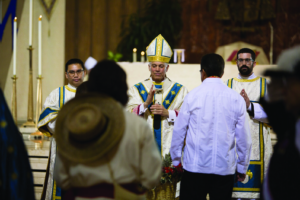
Photos from a “Mass of the Americas” celebrated in the Archdiocese of San Francisco by Cordileone.
On November 16, a special Holy Mass was celebrated in the Extraordinary Form at the National Shrine of Our Lady of the Immaculate Conception in Washington, D.C. The Mass, called “Mass of the Americas,” is a unique adaptation of the classical Mass texts into artistic forms of the Americas. Moreover, it is adaptable to the Extraordinary Form.
Archbishop Salvatore Cordileone, President of the Benedict XVI Institute for Sacred Music and Divine Worship, spoke to Inside the Vatican about the meaning of this original composition and what true “inculturation” is. What follows is the first of two parts:
Inside the Vatican: You are the president of the Benedict XVI Institute for Sacred Music and Divine Worship, based in San Francisco at the diocesan seminary. What inspired the foundation of that institute?
Archbishop Salvatore Cordileone: The original idea was to enhance the quality of the liturgy in our parishes and to provide resources so that our liturgies would be more vibrant, more beautiful, more reverent, and with a deeper sense of the sacred. As I deliberated this, with input of others advising me, we developed the sort of standard edition that approaches the goal another way, such as with the continuous “revived” resources we are providing to parishes, that seek to help parishes learn how to sing chant; conducting chant camps for children; and teaching school choirs.
But also we are reviving a Catholic culture of the arts, recognizing that the Church has always been a great champion of the arts, a patron of the arts, and the beauty of truth, beauty and goodness. But the Church has been pretty much absent from that for the last 50 years or so, so we are revitalizing a Catholic culture of the arts, and we teach through the works of Catholic artists; we have an online course, we have a lecture series on all the areas of art; we work with screenwriters from Hollywood — a screenwriter who went to a Christian school for screenwriting for Hollywood — with people of the art of literature as well as the art of music. We have concerts and sacred liturgies using sacred music. We have recruited a composer in residence, Frank La Rocca, a very accomplished composer of sacred music who will join our efforts in the Bay Area, a big area for which to compose new compositions of sacred music. You may have heard of the first one he did, which we call the “Mass of the Americas.”
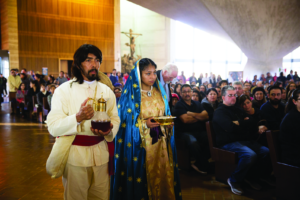
The idea was, last year in the archdiocese we had a large celebration of Our Lady of Guadalupe the Saturday before the feast day… There is a long procession with music and cowboys and all kinds of cultural things before the Mass, to vary the celebration. Honoring Our Lady of Guadalupe is an opportunity to hold up Our Lady as the mother of all of God’s children who unites us into one family.
So I asked Frank to compose this Mass of sacred music, in the sacred music of polyphony, but to incorporate the sounds and even some melodies of popular songs that people sing for Our Lady of Guadalupe… He did a lot of research and accomplished what I had asked. The analogy, the idea, to him, was what the Franciscan friars did in building the mission churches. It is a whole new development of church architecture, mission church architecture, which is the traditional Catholic Church, clearly in that tradition, but it also reflects the local culture in the materials that are used and also the style of art. That’s what we did and we are now sort of taking it on the road.
I celebrated a Mass with the Archbishop of Tijuana there; actually, it was the concluding Mass of a national conference on liturgical music. People from all over Mexico in the area of liturgical music were participating. The closing Mass for that night I celebrated and preached. The Mass, choir, and musicians came from the U.S. side of the border, so it was a real moment of unity. Now, I don’t know if you heard: the abbot scheduled a performance for the Basilica of the National Shrine of the Immaculate Conception in Washington, D.C. This time it will be in the form of an Extraordinary Form Mass.
So I asked Frank to adapt the music to the Extraordinary Form. He did the original composition, most of it, in Latin, but there are a few parts in Spanish, a couple of parts in English. He even composed a Communion meditation which is the Hail Mary in Nahuatl, the language of the Aztec people. It is the language Our Lady actually spoke to Juan Diago. He composed the canticles around it as kind of the introit at the beginning of the Mass. Those vernacular pieces we cannot use within the Mass itself; we can use them outside the context of the Mass. And the Mass cards are in Spanish or in English; we had to translate into Latin. So he adapted this music to the Extraordinary Form Mass. We want to show that it’ll be the same music.
A special set of vestments were made for this by UltraWorthy — very beautiful vestments. Again, the vestment maker really put a lot of thought into the symbolic meaning of the vestments. She even put roses on in the color of the brocade in the middle; the color of the brocade is the color of Mary’s mantle that she is wearing in the image of Our Lady of Guadalupe. She put some roses with the Scripture verse, Psalm 147, which was the basis of the homily I gave. I didn’t ask her to do this…she put on the Latin quote, “Non fecit taliter omni nationi” (“He hath not done in like manner to every nation”), which of course, for Israel, is God entering into the covenant with the people and giving them this higher law. But it is then applied to Our Lady of Guadalupe and the massive effort of evangelization that then happened after that, so many people coming into the Church.
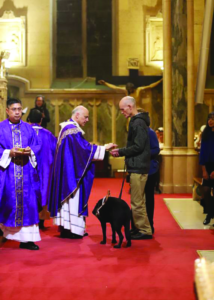
Archbishop Salvatore Cordileone gives Communion to a man with his dog on November 8 at St. Patrick Church in San Francisco (CNS photo/Debra Greenblat, courtesy Archdiocese of San Francisco)
So it will be the same vestments and music, but in the extraordinary Form version of the Mass, albeit a more difficult form of the Mass. So again, it’s another way to show the continuity of the Church in worship and the possibility of the Church to worship in either Form. It’s a living tradition. Sacred music isn’t something of the past, or something confined to concert halls. It was composed for worship; we are using it for worship, and we are developing new compositions of sacred music.
The next one Frank is working on is in the archdiocese here in San Francisco that will be celebrated in November — the Mass will be a special Mass for the dead: a memorial Mass for people who died homeless. And the decision was made to make this an annual Mass. So I asked him to compose a requiem for the homeless. I have these bizarre ideas and somehow he manages to achieve them. To convey the sense of the fear and uncertainty and hecticness of life on the streets, somehow to convey that in sacred music. To do it you need to know about homelessness…so you can really understand it from the inside out.
The hope is that it will revitalize again the Catholic culture that Holds sacred art in all forms, to have theChurch worship, giving glory to God. But also the contribution that Catholics make to the whole world of art, even in the secular realm. That somehow this revitalization will have a ripple effect into the parishes, creating a greater desire for this high form of beauty in our liturgies. And again to continue to provide these practical resources for the parishes.
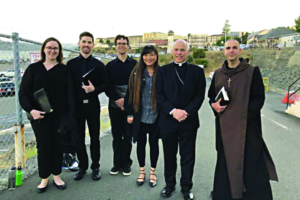
The Benedict XVI Institute’s schola with Archbishop Cordileone and Father Cassian outside San Quentin State Prison, August 5, 2018 (Photo courtesy of the Benedict XVI Institute)
In fact, the teaching choir we just formed a couple of years ago, another part of this effort, is in the festival of Mary we do in May now, every Sunday. To hear classic chants, polyphony, and hymns to Our Lady from different history and different cultures; to celebrate that in our cathedral, it’s a “lessons and chorals” sort of format so it’s not just a concert: it is prayer, there are Scripture readings, and other readings from Fathers of the Church. Some of the hymns the people sing together; the choir will do more complex hymns in a polyphony sort of style. So we do that in May.
Two years ago — a year and a half — I was going to the San Quentin State Prison in the archdiocese. I celebrate Mass there quite frequently. I was walking with the chaplain toward the entrance of the prison when he asked me what I was doing later that day. That was our first one, our first festival of Marian hymns, and I explained to him about the institute, about the teaching choir, and he said, “Oh! Can they come here and teach the men how to sing chant?” So we did that. A couple of months later we had a concert. They do have a dedicated Catholic chapel (not too many prisons do). We had a concert of chant in the chapel in the prison, and our teaching choir was there. It was well attended and about thirty of the men signed up to be part of a Gregorian chant schola. There is now a schola, a Gregorian chant schola, inside the San Quentin State Prison…
So we are seeing how beauty has the power to heal the spirit. Someone else whom, through the institute, we are working within San Diego, has been teaching and working with women who are victims of human trafficking — to sing Gregorian chant, ancient Hymns to the Virgin Mary, to help in their healing process, in getting their life back together. [We] try to hold up the power of beauty for healing and for unity to these different efforts and resources.
The conclusion of ITV’s interview with Archbishop Cordileone appeared in our February 2020 issue and can be viewed here.

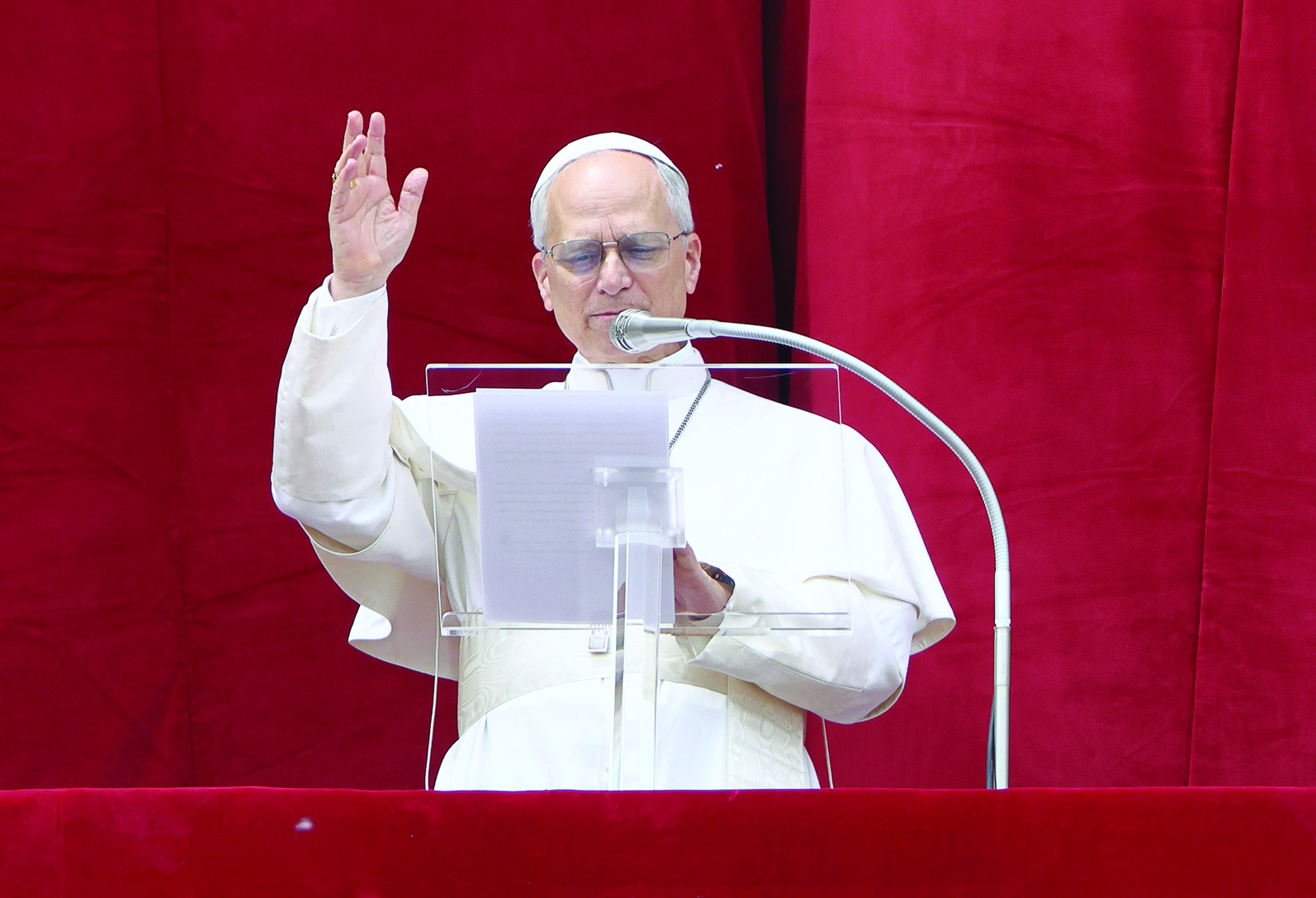

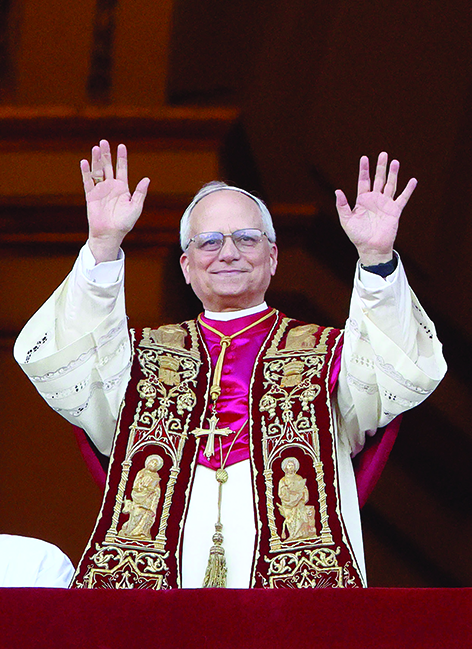
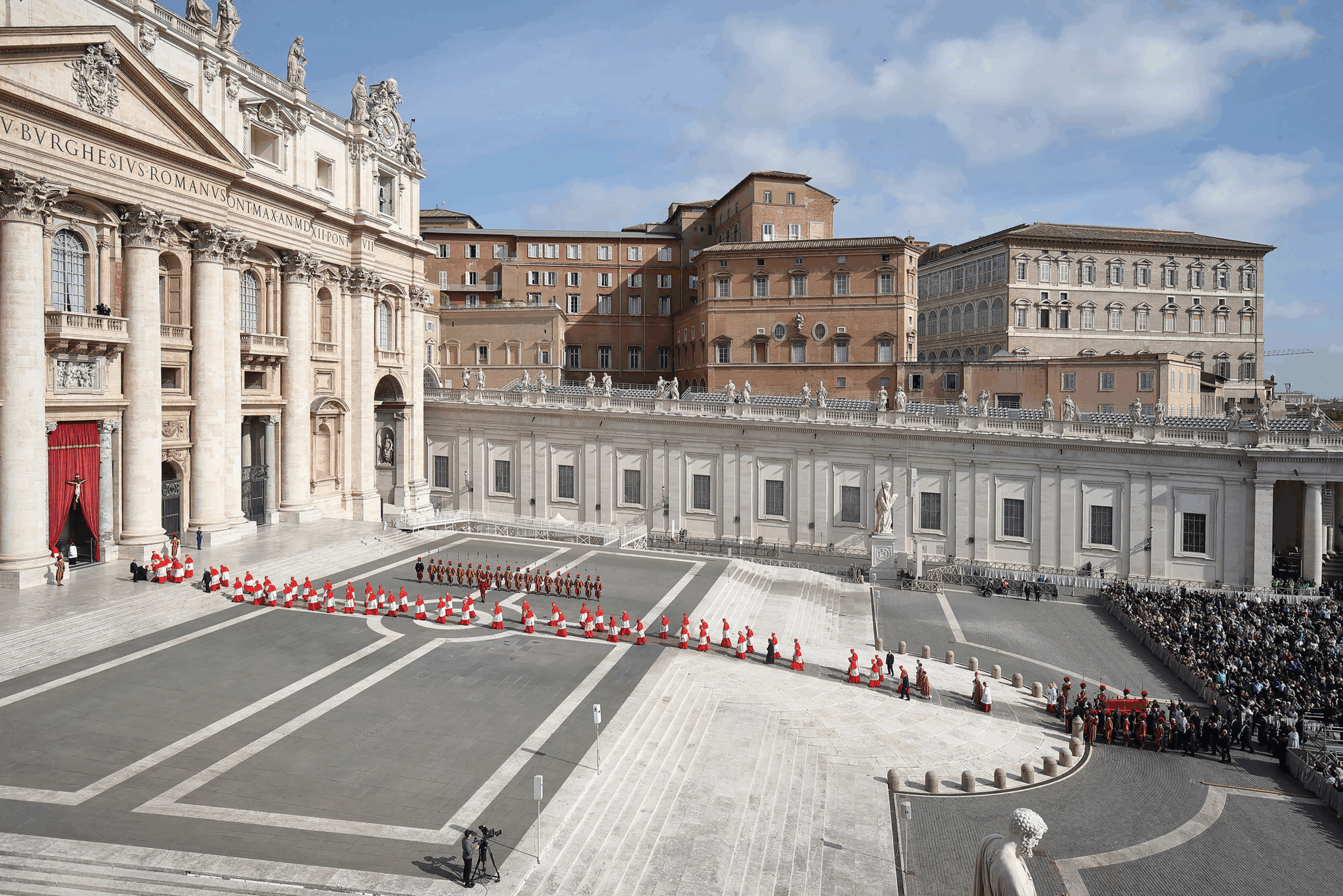
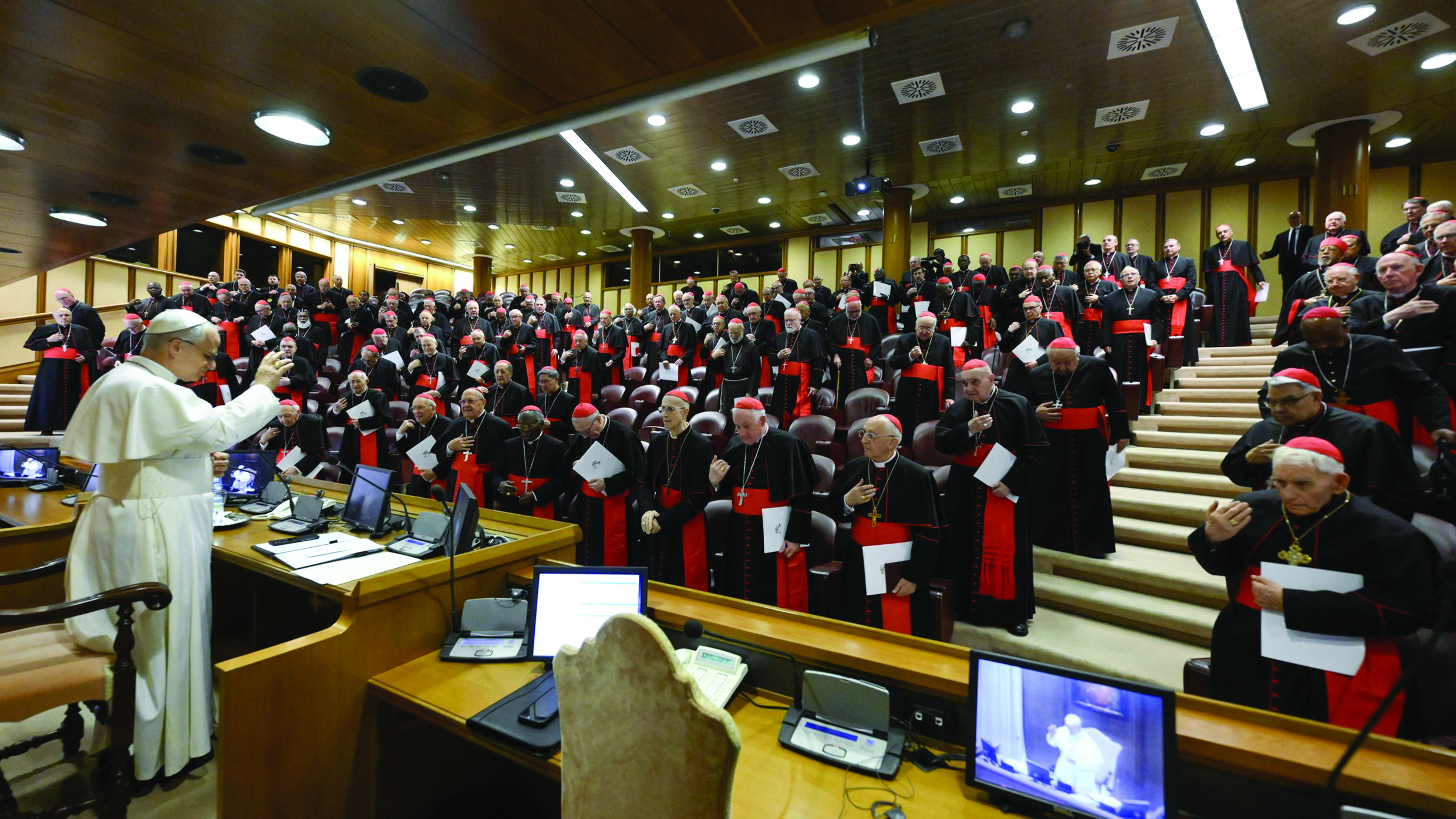
Facebook Comments